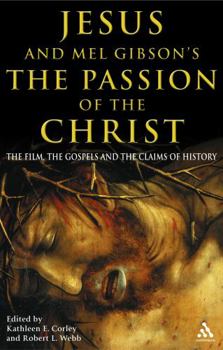Jesus and Mel Gibson's the Passion of the Christ: The Film, the Gospels and the Claims of History
Select Format
Select Condition 
Book Overview
An exciting and engaging book that will appeal not only to academics but to the film-viewing public, educated lay-persons and students. Not only will the book aid this audience in a greater... This description may be from another edition of this product.
Format:Paperback
Language:English
ISBN:082647781X
ISBN13:9780826477811
Release Date:August 2004
Publisher:Bloomsbury Publishing PLC
Length:208 Pages
Weight:0.64 lbs.
Dimensions:0.6" x 5.6" x 8.5"
Customer Reviews
1 rating
Where history ends and myth begins...
Published by Thriftbooks.com User , 19 years ago
This is a good book for anyone interested in how Mel Gibson's film relates to the Jesus of history, and the editors generally take the right approach: "We should not impose what we want Gibson to do with his movie but rather seek to understand, appreciate, and critique what he has done." Aside from one contributor (Crossan), the twelve authors do a fairly good job of this. The first part presents two overviews of the film written by John Dominic Crossan and Mark Goodacre. Differences in tone, reason, and sanity cannot be overstated. Crossan's is a sanctimonious indictment and hard to take seriously, with preposterous overstatements found on every page: "If this film is not anti-Semitic, no such film can ever be made." In fact the film is no more anti-Semitic than the gospels, and considerably less so than Matthew and John. "Any Christian who accepts the Emmerich-Gibson theology of vicarious atonement is trapped in support of pornographic sadism." While the violence is extreme and the gore a blood-bath, neither is gratuitous. The subject matter demands them. Pornography encourages the viewer to want more, and the film does precisely the opposite. In effect Crossan serves as the foil against which Goodacre radiates sound judgment. The latter's essay is easily the book's finest: well-organized, well-written, explaining why the film can offer a powerful vision to Christians and non-Christians alike. The second part is half the book and deals with particular subjects: the flashbacks (Robert Webb), the character of Judas (Scot McKnight), the figure of Satan (Mark Allan Powell), Mary and the women (Kathleen Corley), the Jewish leaders (Alan Segal), the Romans (Helen Bond), the trials of Jesus (Glenna Jackson), and the procession/crucifixion (Craig Evans). Webb thinks the flashbacks are key to comprehending Gibson's vision: "without them the film would be a pointless gore-fest". I disagree. The flashbacks are unnecessary and distractive given the film's focus. And Jesus' passion isn't pointless; the context is supplied by familiarity with the gospel stories. I agree, however, with Webb's conclusion that Gibson's use of the flashbacks is "problematic and inadequate", not only because they insufficiently communicate the significance of Jesus, but because the viewer's own image of Jesus can provide all the framework one needs. Gibson's snapshots are too brief and superficial. In any case, Webb's individual commentaries on the flashbacks are helpful. McKnight explains why Judas' betrayal and suicide is likely historical, while his demonization in the film is mythological though dramatically effective. Powell argues that the androgynous and alluring figure of Satan, while not exactly true to the gospels (let alone history), is a well-used and convincing representation of evil. Corley corrects Gibson's association of Mary Magdalene with the adulteress of Jn 8, and opines that both Marys should have been in the flashbacks with the disciples -- since histo





